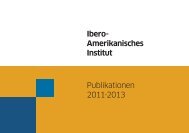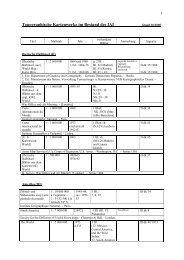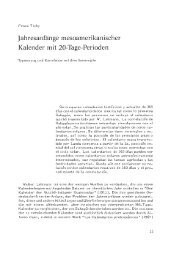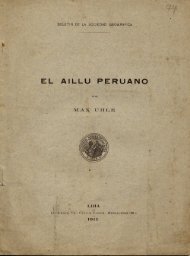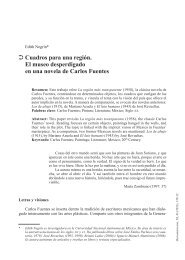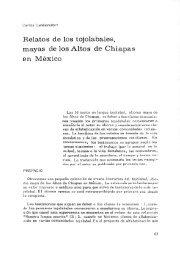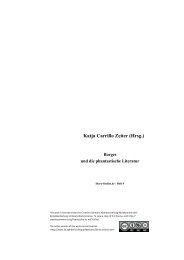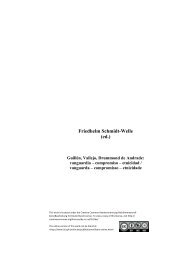The Mennonite Colonies in Paraguay. Origin - Ibero-Amerikanisches ...
The Mennonite Colonies in Paraguay. Origin - Ibero-Amerikanisches ...
The Mennonite Colonies in Paraguay. Origin - Ibero-Amerikanisches ...
You also want an ePaper? Increase the reach of your titles
YUMPU automatically turns print PDFs into web optimized ePapers that Google loves.
14<br />
Table 5: Some basic data about the colony of Neuland (1948-1958)<br />
1948 1953 1958<br />
Inhabitants 2,389 2,462 1,715<br />
Villages 25 27 25<br />
Farms 538 473 318<br />
Crops planted (ha)<br />
Cotton 157 985 981<br />
Kaffir 126 1,066 870<br />
Peanuts 73 531 362<br />
Trees (number)<br />
Fruit trees 170 6,333 11,938<br />
Paraiso 462 9,205 9,004<br />
Domestic animals<br />
Horses 113 1,715 1,367<br />
Cattle 588 7,437 8,841<br />
Pigs 110 950 450<br />
Chickens 1,527 11,361 13,028<br />
Farm implements<br />
Farm wagons 45 420 291<br />
Buggies 2 173 264<br />
Plows 65 528 436<br />
Harrows 1 41 101<br />
Cultivators 24 469 393<br />
Planters – 142 261<br />
Tractors 0 – 4<br />
Trucks 0 – 5<br />
Autos and Jeeps 0 – 2<br />
Source: Fretz (1962: 97-99).<br />
In the beg<strong>in</strong>n<strong>in</strong>g, market<strong>in</strong>g possibilities were severely hampered by the lack of good communications.<br />
<strong>The</strong>re were no good roads or even no roads at all. <strong>The</strong> villages had to be connected by picadas. Goods<br />
from Asunción arrived by tra<strong>in</strong> at km 145 of the narrow-gauge l<strong>in</strong>e owned by the Carlos Casado Company.<br />
From that po<strong>in</strong>t (Fred Engen) they had to be transported to the colonies <strong>in</strong> ox or horse drawn<br />
carts. All citizens had to carry out one or more transports dur<strong>in</strong>g the year and deliver the goods to the<br />
cooperative. Each journey took 1-2 weeks, dur<strong>in</strong>g which time the drivers had to care for themselves at<br />
their own expense and had to cope with dust, heat, <strong>in</strong>sects, <strong>in</strong>undated road sections etc. From the<br />
1950s, the colonist could make use of mach<strong>in</strong>es to build relatively good earth roads and, gradually, a<br />
fairly good road network developed with<strong>in</strong> and between the colonies. All roads were built without<br />
external help (Dürksen/Harder 1980: 55). <strong>The</strong> situation improved drastically when the Trans Chaco<br />
Road (Ruta Transchaco) was completed. This earth road from Asunción towards the Bolivian border<br />
was built with the assistance from the US Agency for International Development and reached Filadelfia,<br />
the urban centre of the <strong>Mennonite</strong> colonies, on 4 October 1961. On 10 September 1964 the section<br />
to the settlement of General Eugenio A. Garay, which lies 5 km from the Bolivian border, was <strong>in</strong>augurated.<br />
<strong>The</strong> total distance from Asunción to the latter settlement is 776 km. Asphalt<strong>in</strong>g began <strong>in</strong> the<br />
1970s and was completed as far as Filadelfia <strong>in</strong> the mid-1980s. In 1978 the Puente Remanso Castillo<br />
provided a road bridge l<strong>in</strong>k<strong>in</strong>g the Trans Chaco Road to Eastern <strong>Paraguay</strong>. 10<br />
10 Nickson (1993: 223, 590-591); Ratzlaff (1999: 184), Unruh (1973: 106). For more details about the history and importance<br />
of the Ruta Trans Chaco see the publications of Ratzlaff.<br />
<strong>Ibero</strong>-Bibliographien 5



